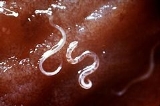
Rhabditia
Encyclopedia
Subclass Rhabditia is mostly composed of parasitic nematodes (particularly in the Strongylida
), though there are some free-living species as well (particularly in the Rhabditida
). Phasmids (posterior sensory structures) are well-developed, while amphid
s (anterior sensory structures) are poorly developed or absent in this group.
In an alternate classification system, they are treated as suborder Rhabditina, with the orders listed here being ranked as infraorders. Also, the Diplogasterida
, which are sometimes considered a monotypic
subclass, are probably better placed in the Rhabditia. On the other hand, the old placement of the Ascaridida
in Rhabditia instead of Spiruria
seems unwarranted. The Rhabditida
contain a number of families
which are probably better placed in the Tylenchia; alternatively, the latter group may entirely be merged with the Rhabditia.
Strongylida
The Suborder Strongylida includes many of the important nematodes found in the gastrointestinal tracts of ruminants, horses, and swine, as well as the lungworms of ruminants and, the hookworms of dogs and cats.This Suborder includes The Suborder Strongylida includes many of the important nematodes...
), though there are some free-living species as well (particularly in the Rhabditida
Rhabditida
Rhabditida is an order of free-living, zooparasitic and phytoparasitic microbivorous nematodes .Order include 8 superfamilies.Diagnosis:...
). Phasmids (posterior sensory structures) are well-developed, while amphid
Amphid
Amphids are inervated invaginations of cuticle in nematodes. They are usually found in the anterior region of the animal, at the base of the lips. Amphids are the principal chemosensory organs of nematodes. Each amphid is made up of 12 sensory neurons with ciliated dendrites....
s (anterior sensory structures) are poorly developed or absent in this group.
In an alternate classification system, they are treated as suborder Rhabditina, with the orders listed here being ranked as infraorders. Also, the Diplogasterida
Diplogasterida
Diplogasterida is an order of nematodes. It is sometimes placed in a monotypic subclass Diplogasteria, but as it seems it is better included in the Rhabditia. If the Tylenchida are included in the Rhabditia, the Diplogasterida certainly would have to be merged there too-References: : . Version of...
, which are sometimes considered a monotypic
Monotypic
In biology, a monotypic taxon is a taxonomic group with only one biological type. The term's usage differs slightly between botany and zoology. The term monotypic has a separate use in conservation biology, monotypic habitat, regarding species habitat conversion eliminating biodiversity and...
subclass, are probably better placed in the Rhabditia. On the other hand, the old placement of the Ascaridida
Ascaridida
The order Ascaridida includes several families of parasitic roundworms with three "lips" on the anterior end. They were formerly placed in the subclass Rhabditia by some, but morphological and DNA sequence data rather unequivocally assigns them to the Spiruria...
in Rhabditia instead of Spiruria
Spiruria
Subclass Spiruria comprises mostly parasitic secernentean nematodes. In an alternate classification, they are treated as suborder Spirurina, with the orders listed here being ranked as infraorders....
seems unwarranted. The Rhabditida
Rhabditida
Rhabditida is an order of free-living, zooparasitic and phytoparasitic microbivorous nematodes .Order include 8 superfamilies.Diagnosis:...
contain a number of families
Family (biology)
In biological classification, family is* a taxonomic rank. Other well-known ranks are life, domain, kingdom, phylum, class, order, genus, and species, with family fitting between order and genus. As for the other well-known ranks, there is the option of an immediately lower rank, indicated by the...
which are probably better placed in the Tylenchia; alternatively, the latter group may entirely be merged with the Rhabditia.

